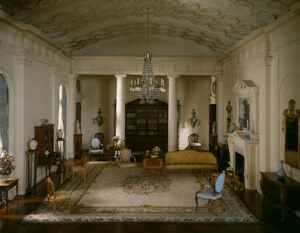
English Great Room of the Late Tudor Period, 1550-1603, E-1, Narcissa Niblack Thorne (Designer), 1932-1937, Scale 1 inch = 1 foot, Gift of Mrs. James Ward Thorne, Art Institute of Chicago, CCO Public Domain.
Giles Grendy is a New York City based dealer of fine English furniture dating from the 17th to 19th Centuries. His business grew out of his earlier work as a restorer. Giles learned that he could make a career discovering furniture in unexpected places, restoring it, and then selling it for a tidy profit, all the while enjoying mending, wheeling and dealing, and meeting new people along the way. What’s not to like!
Being a dealer in New York City was certainly loads of fun in the 1980s and 90s. Since then, periodic economic downturns, the 9/11 attacks, the Pandemic, and changing tastes have taken some bloom off the rose. Giles thought to himself that at least he wasn’t in the same boat as the New York City antiquities dealers he knew.
Back in the 70s and into the 90s, they used to enjoy their work as much as he did, with the added bonus of exotic foreign travel. But after they became targets of well financed and politically connected archaeological advocacy groups who blamed them for “looting” in the Times, things began to sour. It only got worse in the 90s when all that negative press coverage encouraged law enforcement to make busts based on applying draconian foreign national patrimony laws here. Since then, their business has dried up, leaving only a few survivors fighting over a limited number of pieces provenanced to “old collections.” Not much fun there. So, most just retired or scaled back dramatically.

English Reception Room of the Jacobean Period, 1625-55, E-3, Narcissa Niblack Thorne (Designer), 1932-1937, Scale 1 inch = 1 foot, Gift of Mrs. James Ward Thorne, Art Institute of Chicago, CCO Public Domain.
At least, Giles felt some solace in that fine English furniture is “safe.” It’s legal to buy and sell in both the US and the UK. Indeed, it is highly unlikely that the UK will suddenly declare national ownership and control over all those Georgian mahogany tilt top tripod tables that have graced the Great Houses of England for centuries.
But that doesn’t mean continued smooth sailing, at least as far as doing business in the European Union (EU) is concerned. Giles, who always has his ear to the ground, heard about new regulations being applied to imports into the EU for cultural goods over 200 years old and created or first discovered outside that trade bloc. They were passed back in 2019 after some of the same archaeological advocacy groups convinced decision-makers there that the trade in all cultural goods, not just antiquities, was a major funding source for criminals and terrorists. Of course, such grossly overblown claims were later debunked, but the damage was already done. EU decision makers reacted to such inflammatory allegations without thinking through the consequences for legitimate micro and small businesses buying from and selling to established clients.

English Bedroom of the Georgian Period, 1760-75, E-8, Narcissa Niblack Thorne (Designer), 1932-1937, Scale 1 inch = 1 foot, Gift of Mrs. James Ward Thorne, Art Institute of Chicago, CCO Public Domain.
It was easy for many of Giles’ peers to ignore these rules at first, because although they were passed in 2019, they were not to go into effect until six years later, in June 2025 after the rollout of a web-based import system. Now that 2025 is just around the corner, however, Giles has heard that European dealers have finally started to raise the alarm to anyone who will listen that the new rules will require evidence for legal import that simply does not exist for most items. Those importing archaeological objects are worst off because these objects are treated as “high risk” items. Proof of legal export from the country where they were created or discovered must be provided for all such items as there is a Zero € value threshold for all required import licenses.
All other cultural goods, including fine English furniture, are placed in the “low risk” category. This means they can be imported with an “importer’s statement” that makes similar representations of legal export if they are valued at over €18,000 and are over 200 years old. Items under €18,000 in value can simply be imported without any such requirements, although they will still be subject to seizure if the authorities believe them to have been illegally exported from a UNESCO member state.

English Drawing Room of the Georgian Period, 1770-90, One of sixty-eight Thorne Miniature Rooms, Narcissa Niblack Thorne (Designer), E-9, made in US, made 1932-1937, Scale 1 inch = 1 foot, Gift of Mrs. James Ward Thorne, Art Institute of Chicago, CCO Public Domain.
There are two procedural exceptions or “derogations” that apply to both “high risk” archeological items as well as other “low risk” items. The first is for items where it cannot be determined where they were created or first discovered. These can be imported with proof that they were legally exported from a country where they resided for five years. The other derogation is for material that has a provenance outside its country of origin dating back to 1972. Again, even these can be imported only if the material was legally exported from a country where they resided for five years.
Obviously, as Giles knows where fine English furniture was created, he will not be able to take advantage of the first derogation. This leaves the second derogation, one which may be difficult to use in practice as relatively few items have a demonstrated provenance before 1972.
So what will this mean for Giles’ business? The fact that regulations default to the source country’s export rules may cause serious anomalies even for cultural goods one might assume to be free to trade. Giles considered this scenario. Giles sells mostly in the US and the UK, but he has at least one good client in France. That client is one of those eccentric Frenchmen who relishes being “different.” And what can be more “different” than collecting English furniture in a land known for its fine Louis XIV and Napoleonic style pieces?

English Rotunda and Library of the Regency Period, 1810-20, E-13, Narcissa Niblack Thorne (Designer), 1932-1937, Scale 1 inch = 1 foot, Art Institute of Chicago, CCO Public Domain.
Giles decided to think through what has to happen when this French client wants to purchase a piece after June 2025. The US has no export controls on such material, but the UK does for such items valued over £ 65,000. If the piece of English furniture was valued over that threshold and did not have a provenance before 1972, it would be impossible for a French collector/importer to make a valid “importer’s statement.” So, instead, Giles will be forced to engineer a “work around” by importing the piece of furniture into the UK, and then seeking an export license from UK authorities. Sounds like an expensive hassle. And who will pay for the extra red tape? Giles doesn’t have all the answers yet and hopes he can find a reasonable solution for this French client after the regulations go into effect soon.
Next Installment: Repatriating Art and Antiquities to Failed States No Recipe for their Safety or Preservation
Further Reading:
Riah Prior, Art trade figures voice major concerns over new EU import licensing regulations, The Art Newspaper (March 18, 2024)
Kate Fitz Gibbon, RAND Corp Report Demolishes Assumptions on Antiquities and Terror, Cultural Property News (July 30, 2020).
Kate Fitz Gibbon, EU Regulation Curtailing Import of Art & Antiquities Now Law, Cultural Property News (June 16, 2019).
Importing Cultural Goods, EUR-Lex.
[1] Peter K. Tompa is a semi-retired lawyer who resides in Washington, D.C. He has written extensively about cultural heritage issues, particularly those of interest to the numismatic trade. Peter contributed to Who Owns the Past?” (K. Fitz Gibbon, ed. Rutgers 2005). He formerly served as Executive Director of the Global Heritage Alliance and now is a member of its Board of Directors. He currently serves as the Executive Director of the International Association of Professional Numismatists. This article is a public resource for general information and opinion about cultural property issues and is not intended to be a source for legal advice. Any factual patterns discussed may or may not be inspired by real people and events. The opinions stated in this article are the author’s alone and should not be attributed to any affiliated organization.
 English Dining Room of the Georgian Period, 1770-90, One of sixty-eight Thorne Miniature Rooms, Narcissa Niblack Thorne (Designer), E-10, made in US, made 1932-1937, Scale 1 inch = 1 foot, Gift of Mrs. James Ward Thorne, Art Institute of Chicago, CCO Public Domain.
English Dining Room of the Georgian Period, 1770-90, One of sixty-eight Thorne Miniature Rooms, Narcissa Niblack Thorne (Designer), E-10, made in US, made 1932-1937, Scale 1 inch = 1 foot, Gift of Mrs. James Ward Thorne, Art Institute of Chicago, CCO Public Domain. 

